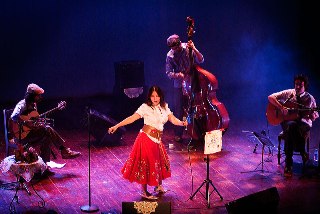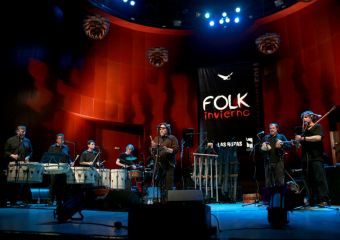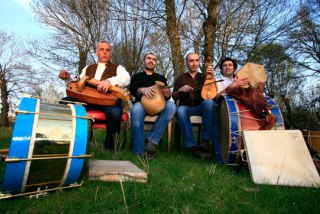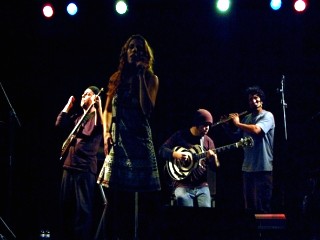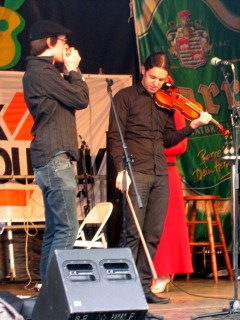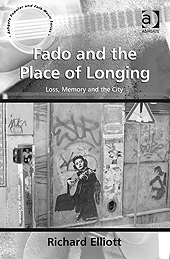FolkWorld #47 03/2012
© Wikipedia, the free encyclopedia
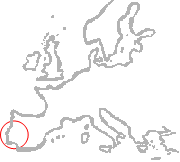 Portuguese Republic (República Portuguesa)
Capital:
Portuguese Republic (República Portuguesa)
Capital: Lisbon
Population: 10,7 mio.
Location:
Southwestern Europe on the Iberian Peninsula. Portugal is the westernmost country of Europe, and is bordered by the Atlantic Ocean to the west and south and by Spain to the north and east. The Atlantic archipelagos of the Azores and Madeira are part of Portugal.
Music of Portugal
In 2012, Guimarães - Cidade Berço, the birthplace and cradle of the Portuguese nationality -
is going to be European Capital of Culture,
jointly with Maribor, Slovenia.[47]
Portugal is internationally known in the music scene for its traditions of fado, but the country has seen a recent expansion in musical styles, with modern acts from rock to hip hop becoming popular. If Amália is still the most recognizable Portuguese name in music, today the biggest exportations are bands like Moonspell (metal), Madredeus (fado and folk inspired), Buraka Som Sistema (electro/kuduro/breakbeat), Da Weasel, Sandro G (hip hop), Blasted Mechanism (experimental electro-rock) or Wraygunn (rock, blues), and artists like Mariza (fado). The musicality of the Portuguese language has also inspired non-native speakers to use it in their recordings, for example Mil i Maria. Regional folk music remains popular too, having been updated and modernized in many cases, especially the northeastern region of Trás-os-Montes.
Dance, Rock, pop, kuduro, zouk, kizomba, Heavy metal, house and Hip Hop are among the most popular musical styles in Portugal; however, the recent arrival of revivalist folk bands, such as Deolinda, led to a newfound interest in this type of music.
History
Portuguese music was influenced by music from Ancient Rome's musical tradition brought into the Iberian Peninsula by the Romans and the rich artistic Europen tradition. Its genres range from classical to popular music. Portugal's music history includes musical history from the medieval Gregorian chants through Carlos Seixas' symphonies era to the composers of the modern era. Musical history of Portugal can be divided in different ways. Portuguese music encompasses musical production of the Middle Ages, Renaissance, Baroque, Classical, Romantic and Modern eras.
Folk music
Fado
Fado (fate in Portuguese) arose in Lisbon as the music of the urban poor. Fado songs are typically lyrically harsh, with the singer resigned to sadness, poverty and loneliness, but remaining dignified and firmly controlled.
Starting in 1939 with the career of Amália Rodrigues, fado was an internationally popular genre. A singer and film actress, Rodrigues made numerous stylistic innovations that have made her probably the most influential fadista of all time.
A new generation of young musicians have contributed to the social and political revival of fado music, adapting and blending it with new trends. Contemporary fado musicians like Mariza, Mísia and Camané have introduced the music to a new public. The sensuality of Misia and other female fadistas (fado singers) like Maria Ana Bobone, Cuca Roseta, Cristina Branco, Ana Moura, Katia Guerreiro, and Mariza has walked the fine line between carrying on the tradition of Amália Rodrigues and trying to bring in a new audience. Mísia and Carlos do Carmo are also well known fado singers. Ricardo Ribeiro and Miguel Capucho are one of the best male fado singers of the new generation.
Traditional music
Regional folk music
Recent events have helped keep Portuguese regional folk (rancho folclórico) traditions alive, most especially including the worldwide roots revival of the 1960s and 70s.
Azorean folk music
The people of the Azores islands maintain some distinct musical traditions, such as the traditionally fiddle-driven chamarrita dance.
Trás-os-Montes
Trás-os-Montes' musical heritage is closely related to the music of Galicia, Cantabria and Asturias. Traditional bagpipes (gaita-de-fole transmontana), a cappella vocals and a unique musical scale with equal semitones have kept alive a vital tradition. (Miranda de I Douro), some artists such as Galamdum Galundaina sing in Mirandese language. Also the Pauliteiros folk dance is popular. Some residents sing in both Portuguese and Mirandese.
Popular music
Famous artists and bands included in the past Tonicha, Paco Bandeira, Paulo de Carvalho, José Cid, Linda de Suza, Duo Ouro Negro, Roberto Leal and Ornatos Violeta. Nowadays some of the most popular acts are Aurea, Amor Electro, The Legendary Tigerman, Madredeus, GNR, Xutos & Pontapés, The Gift, David Fonseca, Buraka Som Sistema, Mil i Maria and Boss AC.
Pimba music
Pimba music is the Portuguese version of the euro Schlager or the Balkan Turbo-Folk. Its name cames from a 90s hit Pimba Pimba. Some of its biggest names are Emanuel, Ágata, Ruth Marlene and Quim Barreiros. This genre mixes traditional sounds with accordion, Latin beats and funny or religious (mainly kitch) lyrics.
Political music (Música de Intervenção)
During the reign of the fascist regime music was widely used by the left-wing resistance as a way to say what could not be said, singing about freedom, equality and democracy, mainly through metaphors and symbols. Many composers and singers became famous and persecuted by the political police, some of them being arrested or exiled, such as Zeca Afonso, Paulo de Carvalho, José Mário Branco, Sérgio Godinho, Adriano Correia de Oliveira, Manuel Freire, Fausto, Vitorino, Júlio Pereira and some others.
José Afonso began performing in the 1950s; he was a popular roots-based musician that led the Portuguese roots revival. With artists like Sérgio Godinho and Luís Cília, Afonso helped form nova canção music, which, after the 1974 revolution, gained socially-aware lyrics and became canto livre. The biggest name in canto livre was Brigada Víctor Jara, a group that seriously studied and were influenced by Portuguese regional music.
After the Carnation Revolution, that same music was used to support left-wing parties. Political ideas and causes, like the agrarian reform, socialism, equality, democratic elections, free education and many other were a constant presence in these songs lyrics, often written by well-known poets like José Barata-Moura, Manuel Alegre or Ary dos Santos.
Romantic
The highest exponents of this kind of music in Portugal are Tony Carreira and Marco Paulo (both, and even other performers, have a certain level of overlap with the Pimba genre, even partial or just in certain songs). The poet-singer-songwriter Fausto Bordolo Dias, a significant contributor to the modern romantic genre, can be compared to Leonard Cohen.
Latin
This is a relatively new sound in Portugal. Despite being an Iberian country, Portugal never had clear influences from the Caribbean beats. This style came to the country in the 90s, following a Spanish and world trend. Examples of Latin music singers in Portuguese are Ana Malhoa and Mil i Maria.
Modern acts
African
With immigration from the former colonies, Portugal received many African communities with their different traditional sounds. Some singers were born in Lisbon but still, were singing African influenced music. Two examples are Lura and Sara Tavares, who sing a mixture that includes sounds from Cape Verde.
Fado
Fado (Portuguese pronunciation: [ˈfaðu], "destiny, fate") is a music genre which can be traced to the 1820s in Portugal, but probably with much earlier origins. Fado historian and scholar, Rui Vieira Nery, states that "the only reliable information on the history of Fado was orally transmitted and goes back to the 1820s and 1830s at best. But even that information was frequently modified within the generational transmission process that made it reach us today." In popular belief, fado is a form of music characterized by mournful tunes and lyrics, often about the sea or the life of the poor. However, in reality fado is simply a form of song which can be about anything, but must follow a certain structure. The music is usually linked to the Portuguese word saudade which symbolizes the feeling of loss (a permanent, irreparable loss and its consequent life lasting damage). Amália Rodrigues, Carlos do Carmo, Mariza, Mafalda Arnauth, and Cristina Branco are amongst the most famous individuals associated with the genre.
On November 27, 2011, Fado was inscribed in the UNESCO Intangible Cultural Heritage Lists.
Etymology
The word Fado comes from the latin word fatum, from which the English word fate also originates. The word is linked to the music genre itself and, although both meanings are approximately the same in the two languages, Portuguese speakers seldom utilize the word fado referring to destiny or fate.
History
Fado only appeared after 1830 in Lisbon. It was introduced in the port districts like Alfama, Mouraria and Bairro Alto. There are many theories about the origin of Fado. Some trace its origins or influences to "cantigas de amigo" (friends songs) from the Middle Ages, or Moorish songs, or also to African-Brazilian rhythms. Since there was very much contact between Portugal and its colonies, particularly Brazil (between 1804 and 1822 the Portuguese court resided in Rio de Janeiro since the king had fled from Portugal after Napoleon's invasion), it is not strange that Portuguese fado has some roots in Afro-Brazilian slave dances and also Spanish and Portuguese songs; like Fandango, Semba, Lundu and Modinha and on the other (notice that these roots are similar to those of the Samba). As a consequence, fado was initially very rhythmical and danceable. Fado performers in the middle of the 19th century were mainly from urban working class and sailors, who not only sang, but also danced and beat the fado. During the second half of the 19th century, the African rhythms would become less important, and the performers became merely singers. Fado was thus generally sung by one person called a fadista, and normally accompanied by the portuguese guitar and the classical guitar. The 19th century's most renowned fadista was Maria Severa. More recently Amália Rodrigues, known as the "Rainha do Fado" ("Queen of Fado") was most influential in popularizing fado worldwide. Fado performances today may be accompanied by a string quartet or a full orchestra.
Varieties of fado
There are two main varieties of fado, namely those of the cities of Lisbon and Coimbra. The Lisbon style is the more popular, while Coimbra's is the more classic style. Modern fado is popular in Portugal, and has produced many renowned musicians. According to tradition, to applaud fado in Lisbon you clap your hands, while in Coimbra one coughs as if clearing one's throat.
Coimbra fado
Main article:
Coimbra fado
This fado is closely linked to the academic traditions of the University of Coimbra and is exclusively sung by men; both the singers and musicians wear the academic outfit (traje académico): dark robe, cape and leggings. It is sung at night, almost in the dark, in city squares or streets. The most typical venues are the stair steps of the Santa Cruz Monastery and the Old Cathedral of Coimbra. It is also customary to organize serenades where songs are performed before the window of the woman to be courted.
The most sung themes include: student love, love for the city and bohemian life, and the ironic and critical reference to the discipline and conservative nature of the professors and their courses. Noted singers of this style are Augusto Hilário, António Menano, and Edmundo Bettencourt.
The Coimbra fado is accompanied by either a Portuguese guitar or by a classical guitar. The tuning and sound coloring of the Portuguese guitar in Coimbra are quite different from that of Lisbon. Regarding the Portuguese guitar, Artur Paredes revolutionized the tuning and the accompaniment style to the Coimbra fado, adding his name to the most progressive and innovative singers. Artur Paredes was the father of Carlos Paredes, who followed and expanded on his work, making the Portuguese guitar an instrument known around the world.
In the 1950s, a new movement led the singers of Coimbra to adopt the ballad and folklore. They began interpreting lines of the great poets, both classical and contemporary, as a form of resistance to the Salazar dictatorship. In this movement names such as Adriano Correia de Oliveira and José Afonso (Zeca Afonso) had a leading role in the revolution taking place in popular Portuguese music.
Some of the most famous fados of Coimbra include: Fado Hilário, Saudades de Coimbra (“Do Choupal até à Lapa”), Balada da Despedida (“Coimbra tem mais encanto, na hora da despedida” - the first phrases are often more recognizable than the song titles), O meu menino é d’oiro, and Samaritana. The "judge-singer" Fernando Machado Soares is an important figure, being the author of some of those famous fados.
Curiously, it is not a Coimbra fado but a popular song which is the most known title referring to this city: Coimbra é uma lição, which had success with titles such as April in Portugal.
Fado in North America
Several singers of the traditional Portuguese fado have appeared in Canada and the United States.
One of these, Ramana Vieira, regularly performs in the San Francisco Bay Area without a traditional fado ensemble. Ramana received her formal voice training at San Francisco's American Conservatory Theater and considers herself to be "The New Voice of Portuguese World Music."
From Wikipedia, the free encyclopedia
[en.wikipedia.org/wiki/Music_of_Portugal,
en.wikipedia.org/wiki/Fado].
Wikipedia® is a registered trademark of the Wikimedia Foundation, Inc., a non-profit organization.
Text is available under the Creative Commons Attribution-ShareAlike License.
Date: February 2012.
Photo Credits:
(1) Europe (by FolkWorld);
(2) Portuguese Colours (unknown);
(3)-(4) Deolinda,
(5) Gaiteiros de Lisboa,
(6) Galandum Galundaina,
(8) Uxu kalhus,
(from website);
(7) Dazkarieh,
(10) Stockholm Lisboa Project
(by Walkin' Tom);
(9) OqueStrada (by Tom Kamphans);
(11) Richard Elliott, Fado and the Place of Longing (by Ashgate Publishing).
FolkWorld - Home of European Music
 Layout & Idea of FolkWorld © The Mollis - Editors of FolkWorld
Layout & Idea of FolkWorld © The Mollis - Editors of FolkWorld

